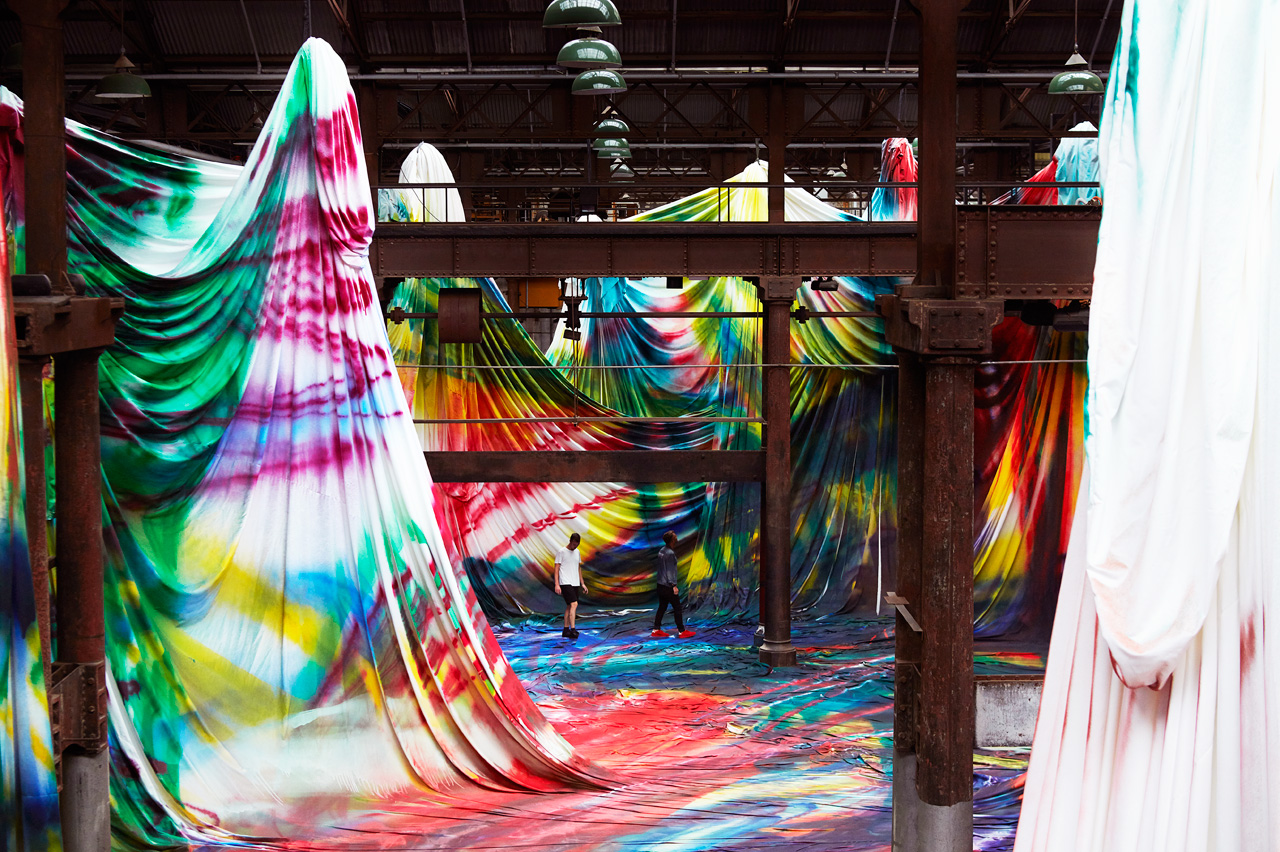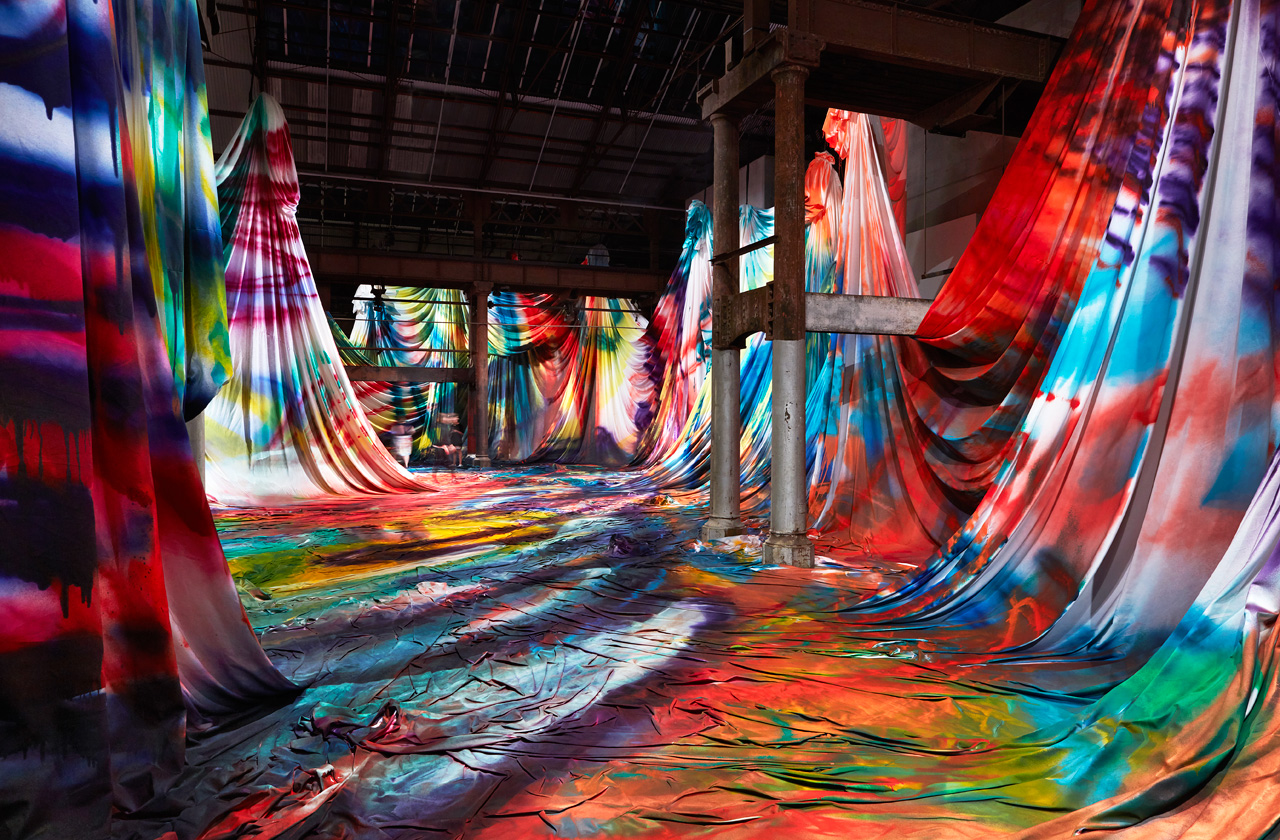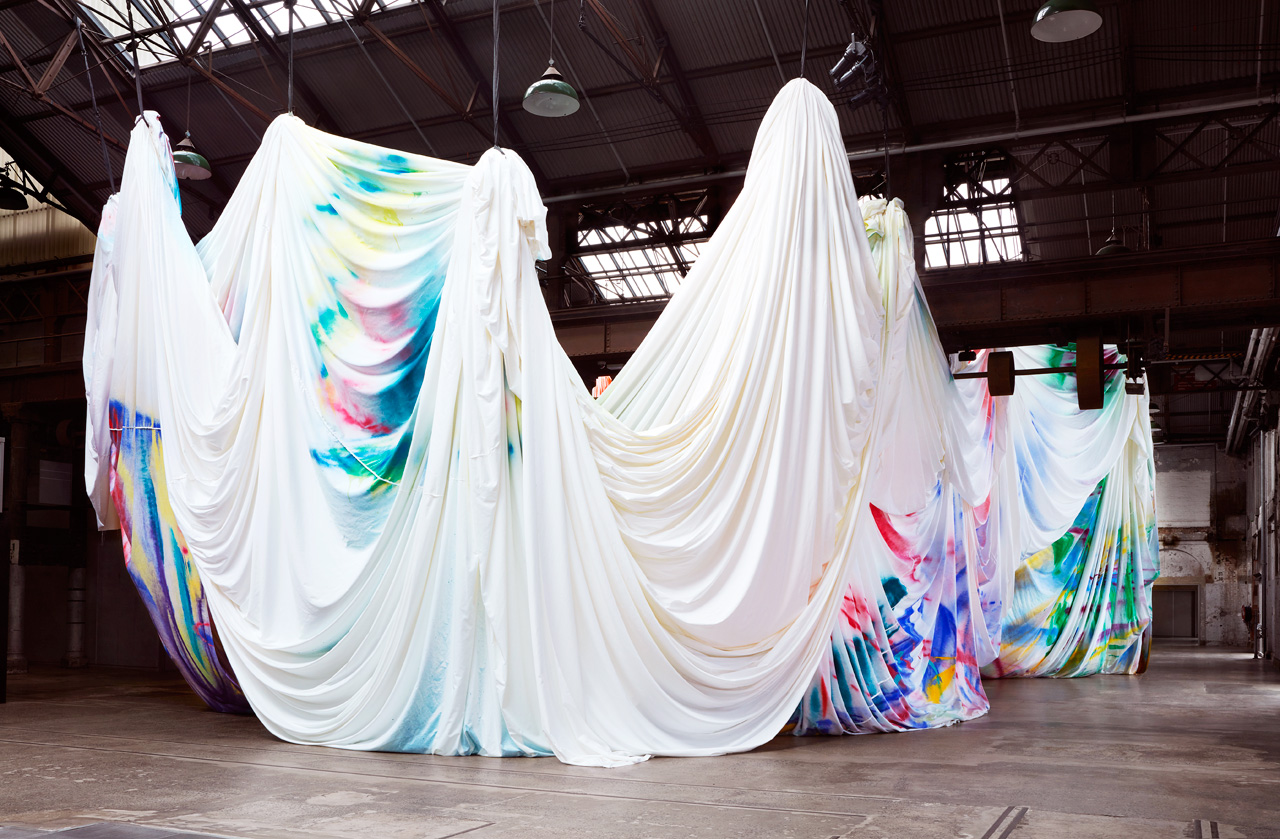News feed
For Katharina Grosse, all the world’s a canvas. The contemporary artist from Germany rarely colours inside the lines provided to her by some of the world’s leading art institutions. The resulting works, invariably rendered in sumptuous colours to astonishing effect, take the form of huge swaths of pigment applied by the artist with a spray gun that are barely able to be contained by traditional notions of the canvas, the natural landscape and architecture alike.
Her most recent work is no exception. The Horse Trotted Another Couple of Metres, Then it Stopped is a site-specific installation exhibiting now at the Carriageworks arts precinct in Sydney commissioned of Grosse by the institution in conjunction with the neighbouring Anna Schwartz Gallery. The third instalment in their ongoing series of major international commissions is perhaps their most ambitious to date. It’s also the most photogenic: Grosse has enveloped the venue’s vast public space in more than 8250 square metres of suspended fabric that an extensive team stitched together, draped, knotted and suspended using the original architectural elements of the building as a loose scaffold. Grosse then spent 10 days freely applying a palette of brilliant, raw colour to create a vast abstract painting over the layers of folds, with the work itself also dictating how it would evolve in a manner not dissimilar from a dialogue with its creator. To stand amongst it is to feel as though you are being swallowed whole by a previously static painting, the folds of which now rise up around you like the waves of a tempestuous sea poised as though on the brink of an ecstatic collapse.
Grosse has exhibited in Sydney before. In 1998, she painted a warm colour spectrum in shades of orange and red along the corridors of the Art Gallery of New South Wales, as part of that year’s Biennale. Where that untitled work seems to suggest an almost institutional restraint, The Horse is entirely gestural, with Grosse discernibly freewheeling and foregoing boundaries in a spirit in keeping with Grosse’s recent site-specific works: namely last year’s This drove my mother up the wall at the South London Gallery, and perhaps most famously, at another untitled installation located along the coast of the Rockaways, in Queens, New York. There, in 2016, she indiscriminately coated an abandoned and hollowed out army base and its surrounds in guttural and fiery reds, pinks and white pigments.
That remarkable work has since been demolished as part of renewed conservation efforts in a region that five years ago was left devastated by Hurricane Sandy. Likewise, The Horse will soon come to its inevitable end, albeit under vastly different circumstances. Below, Grosse discusses her latest ephemeral masterpiece, the processes involved in its creation, and what exactly the titular horse is going to do next.
When did you encounter the space at Carriageworks for the first time and what did you find most striking about it? I came to Sydney early in 2017. What struck me first was the positive energy coming from Lisa Havilah and her team. There was right away an anything-is-possible feel. I saw a chance for creating the very space for the exhibition and the work itself with one and the same move. The skylights of Carriageworks triggered the open form. It’s an old train carriage depot and workshop which is the skin, and inside is something else. There are black box theatres in there, already inserted, so I thought I’ll make something else– a space for painting that is soft. The folds are multi-dimensional. So that was my idea, to use the whole volume but create my own quality of texture.
Your works not only explode traditional notions of the canvas (using unexpected materials and backdrops), but the relationship between the work itself and the participating institution, artist and viewer. How important is context to your work? Could a work such as this exist just as successfully elsewhere, within a different time and place? This work could be installed again, but it would have to be changed, adapted or reconsidered. On the other hand, I am very conscious that a painting has to display its strongest card, which is its independence from any location or site.
The intrusion of original architectural elements into the space provides a glaring contrast between the organic and industrial. Do you consider this incongruence to be indicative of other tensions existing within the work – if so, what are those oppositional forces? I do not see these as oppositional forces but rather simultaneous possibilities. It looks a bit as [though] there are two types of gravity at work, one pulling the masses of material up, the other one stamping them into the ground.
This is the largest scale that you have worked on to date. What has surprised you most about the process, from conception to completion? What always surprises me with such large surfaces [is] that they seem like the smallest possible version of a piece that is a match for the given volume. There are so many different stages in the process of such a large piece, from the first sketches to the many models we had to build, from the first 1:1 folds in the studio to the many Skype meetings with [exhibition manager] Glenn Thompson at Carriageworks and my crew. The fabric had to be sewn, knotted and each knot had to be pulled up slowly by expert riggers. In the end, I came in and painted for another full week, from morning until night. The most amazing thing in the end is for everyone [to see] how all our forces came together. We all stood there at the preview night and could not really say how it happened.
You have been practicing your aerosol-based works for going on two decades now. In what ways have they most significantly evolved over that time? How have they changed you over the same period? I have become more accepting and welcoming to solutions that present themselves in the process.
You’ve said in the past that painting plays by its own rules. Is there a method to the ostensible madness of the colour application in this work? How closely do you plan your palette – is it an analytical or intuitive process? At the beginning it is all intuitive, all starting from my deeply rooted assumption that the painting may behave as independently from the given structure as possible. Once I have committed a considerable amount of visual time and space to this experience, I can have very brief and decisive moments of analysis that lead into another dive into the intuitive process.
Your team sounds as though it is an extensive one. Who do you work with, and how are their contributions evinced in the final work? There is a lot of great expertise in my team from the art historian, current and former gallery directors, or a publishing expert to artists, architecture students, or a trained mechanical engineer. We discuss the proposed projects together and find technical solutions. We plan and organize the different stages of the making of the large in situ works together. The installing is done by a team of young artists that have a great understanding of my work and its intentions. The painting I do myself.
Having recently visited the work on a Saturday morning, the site was teeming with people eager to document themselves within its folds. Some were seen pulling at the surfaces to reveal the untouched fabric underneath – creating white gaps in the paint that remained as they walked away. Is that something you consider in creating a site specific installation – its photogenic qualities as much as its capacity for interactivity? I do not consider pulling folds apart or taking photos in the work a sign of interactivity. Actually, I think it is the contrary. People get taken away from experiencing the painting through looking at their mobile phones. It would be actually great if the audience had to leave their phones outside, as well as the coffee!
Your titles are often linked to stage directions. From what did you derive the title, The Horse Trotted Another Couple Of Meters, Then It Stopped? And, if you could indulge me, what do you think the horse would do next? What if it continued to stop? I found this sentence in the middle of a page when looking for a title for Sydney and it right away struck me as opening intriguing doors alongside the work. It carries the aura of animated action without telling a specific story though. Therefore, the horse could lend its position to any of us.
Another thing that struck me as I stood amidst the work was that the gallery staff were having to constantly ask people who walked in carrying cups of coffee to leave. It occurred to me that, if someone tripped on a fold and spilled a cup of coffee on the previously white fabric underneath, it might just blend seamlessly into the folds of colour. Hypothetically, how would you feel about that – adding another element of audience participation to the work? How attached are you to the preservation of the work in its ‘finished’ state? Why should the audience bring less respect to the painting than I did when I was creating it? My intention is to make a painting that the audience can enter, walk upon and look at. But it is not a play environment, or a carpet to be used up in multiple picnic activities.
As I left the site, I couldn’t help but think: What will happen to the work once its time in the space comes to an end? How will it live on? Is the work’s ephemerality important to you? The work will be in its current iteration until late April. And then we will wait and see!
The Horse Trotted Another Couple of Metres, Then it Stopped is presented free to the public at Carriageworks until April 8, 2018.
Tile and cover image: Zan Wimberley


















